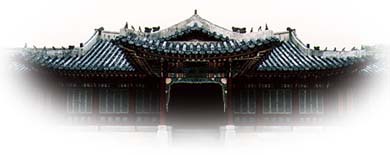

General Information about Korea |
|
|
|
Location |
|
|
The
Korean Peninsula extends |
|
|
Area & Topography |
|
The
total area of the peninsula is 221,607 km2, similar
in size to that of U.K, New Zealand, |
|
|
|
People and Population |
|
Koreans, like many other Asian peoples, are descendants of Mongolian Tungus stock. They differ from the neighboring Japanese and Chinese, however, in that Koreans are a homogene- |
|
ous ethnic group with their own language, culture, and customs. Korean people are characterized by their generosity, warmth, and kindness, and are renowned as one of the hardest working people in the world. Population
: South Korea - 46.9 million(1997) Annual growth rate : 0.90% (1995) Urbanization rate : 78.5% (1995) Average family size : 3.3 persons (1995) Number of foreign residents : 110,028 (1995) |
|
The National Flag and Flower |
|
The Korean flag is called T'aegukki. Its design symbolizes the principles of yin and yang in Oriental philosophy. The circle in the center of the flag is divided into two equal parts. The upper red section represents the positive cosmic forces of yang. Conversely, the lower blue |
|
|
section represents the negative cosmic forces of yin. The two forces together embody the con- cepts of continual movement and balance and harmony that chara- cterize the sphere of infinity. The circle is surrounded by four trigrams, one in each corner. Each trigram symbolizes one of the four universal elements : heaven, earth, fire, and water. The national flower of Korea is the Mugunghwa or |
Rose of Sharon. Every year from June to October a profusion of Mugunhwa blossoms grace the entire country. Unlike most flowers, Mugunghwa is remarkably tenacious and is able to withstand both blight and insects. The flower's symbolic significance stems from Mugunghwa's root word, "Mugung," meaning immortality. This word accurately reflects the perseverance and determination of the Korean people that has been demonstrated throughout their long history. |
|
|
|
General Information about SEOUL |
|
Seoul, the capital of the Republic of Korea, is one of the ten largest cities in the world with a population of over 11 million people living on about 628 square kilometers. The city nestles between two mountain ranges. The Han River flows west to the Yellow Sea and divides the city into two parts. The older section lies to the north, and to the south spread new residential areas, industrial developments as well as satellite cities such as Pundang, Pyongchon, Ilsan and Sanbon. A distinctive characteristic of Seoul is the remarkable ways of yesterday and today blended and its balance to preserve all that is the best in Korea's unique 5,000-year culture. Selected by King Taejo, the founder of the Chosun Dynasty (1392 A.D.-1910 A.D.) as the seat for his throne, Seoul has, for over 600 years, been the focal point of Korean thought, culture, and history. |
|
The downtown core is broadly demarcated by the course of the old city wall. The sections of the wall and its gates that remain intact have been fully restored to their original magnificence. The most famous and visible of these are the South Gate and the East Gate, both officially designated as national treasures. There are many more points of beauty and interest in and around the city. Today, Seoul is the center of the nation's government, education, business, finance, entertain- ment, art, industry and administration. |
|
|
|
Korea experienced the Korean War in the early 50s but recovered from the ruins of the war and achieved a remarkable economic growth since the early 70s, enabling the nation to host the 24th Summer Olympic Games in 1988 in the city of Seoul. |
|
|
|
|
|
- About Seoul & Korea |